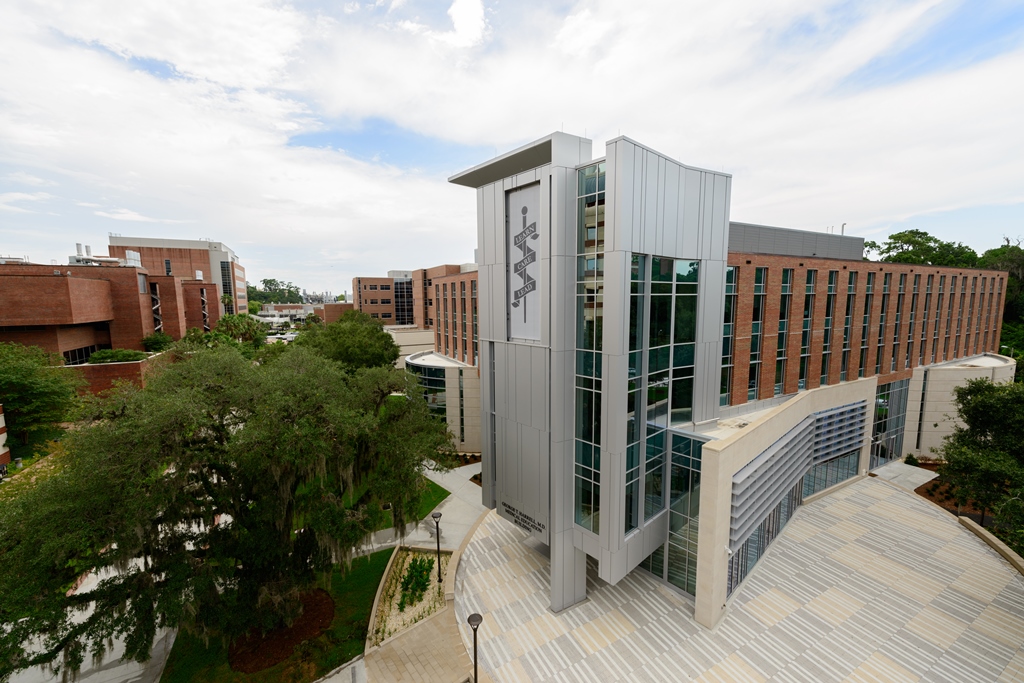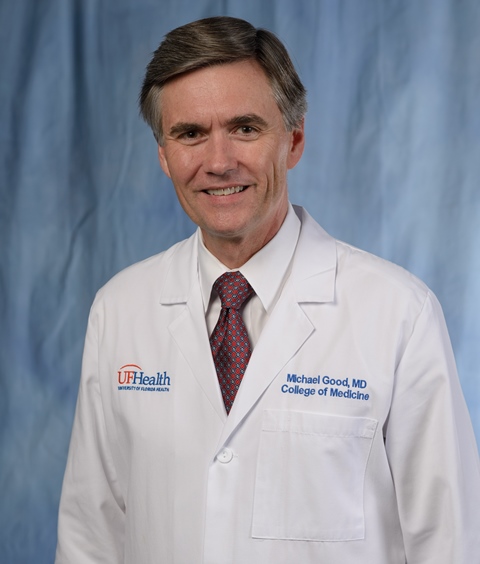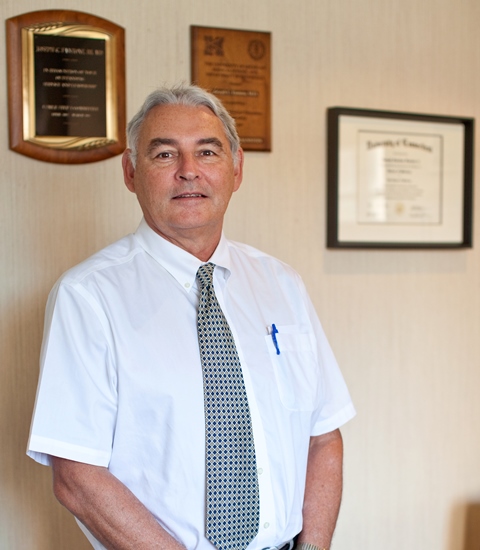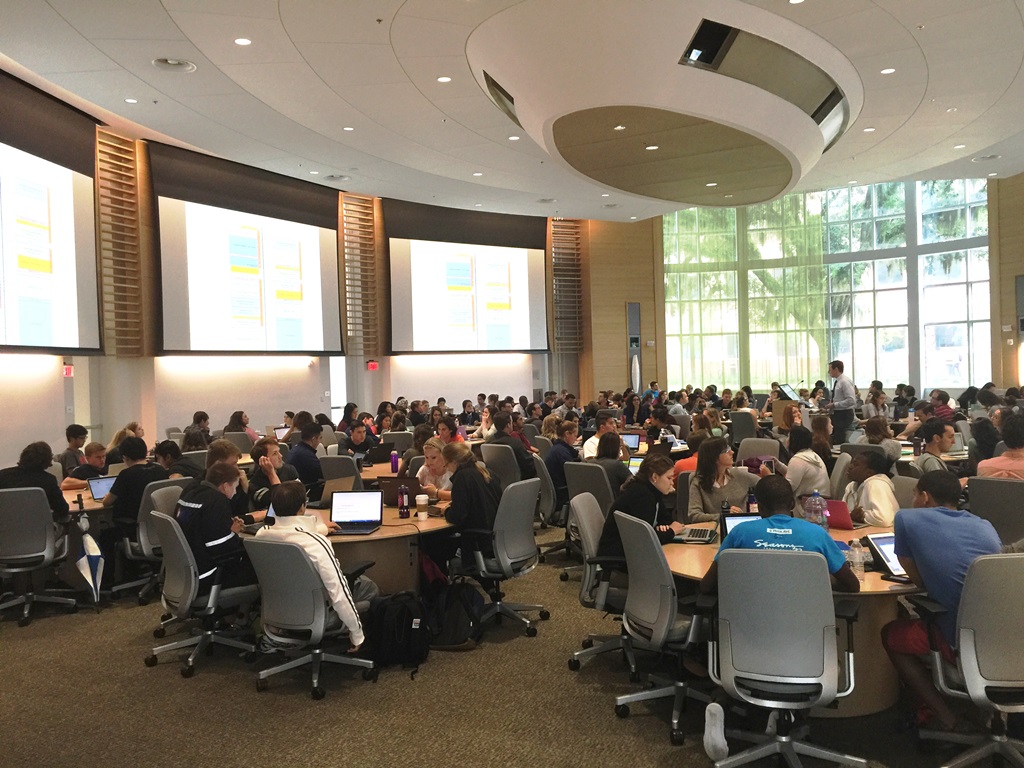The George T. Harrell, M.D. Medical Education Building
On my first day at the University of Florida, in 2009, I had an appointment to visit Dr. Mike Good in the dean’s office of the College of Medicine. I parked with the valet at the entrance of the original William A. Shands hospital, entered the building, and asked directions to the dean’s office. It was a bit of a maze, but I finally found a corridor of offices for medical school administration, among which was the office of the dean.
Over the ensuing months, it became clear that not only was the leadership of the College of Medicine and its educational programs tucked away in space that was not readily accessible to visitors, but the learning environment for the flagship medical school of the Sunshine State was located, as Dr. Good would say, “in the windowless basement of a 1970s building.” If you wanted to meet a visitor to the College of Medicine – e.g., applicants for medical school or residency, visiting professors, or other guests – you couldn’t say “I’ll meet you at the front door of the medical school;” there was no such thing.
A New Front Door, and A New Era
On July 29, 2015, we dedicated and officially opened the new George T. Harrell, M.D. Medical Education Building. We now have not only a gracious entrance to the medical school, but a spectacular facility that marries form and function for medical education like no other in the nation. It is the home of the new curricula for medical students and physician’s assistant students, and a gateway to the academic campus of the UF Health Science Center. As conveyed by the tagline of the ribbon-cutting ceremony, this is truly “a new era” for the UF College of Medicine.

 Let me say at the outset of this story that the University of Florida and UF Health community owe a significant debt of gratitude to dean Mike Good, M.D., who poured himself into this project. First, he raised the money needed to begin construction, crisscrossing the state of Florida to engage with donors. This was a key prerequisite, and Dr. Good conveyed the kind of passion about the project that sparked alumni and friends to open their hearts and their checkbooks. Then, every detail of the Harrell Medical Education Building – from the curriculum it houses, to its siting and design, to the interior spaces and their functionality – evolved under his careful watch.
Let me say at the outset of this story that the University of Florida and UF Health community owe a significant debt of gratitude to dean Mike Good, M.D., who poured himself into this project. First, he raised the money needed to begin construction, crisscrossing the state of Florida to engage with donors. This was a key prerequisite, and Dr. Good conveyed the kind of passion about the project that sparked alumni and friends to open their hearts and their checkbooks. Then, every detail of the Harrell Medical Education Building – from the curriculum it houses, to its siting and design, to the interior spaces and their functionality – evolved under his careful watch.
Form follows function
The story begins in the fall of 2009. Some of the very first conversations I had with dean Good were about the medical school’s curriculum and facilities. It was widely recognized that the curriculum needed to be updated; our goal was to create a new medical education facility that would be designed around a new curriculum.
It was clear that new facilities were needed, but the prospect for a new building initially seemed out of reach. At the time, the nation and the state of Florida were still reeling from the “Great Recession.” The state’s budget included reductions in its base support for the university system, and there was no money available for new construction. We realized that, like the UF Clinical and Translational Research Building, we would need to pay for such projects without state funds.
In Forward Together, the 2010 five-year strategic plan for UF Health, there was an important section related to facilities. The theme was “form follows function” and the plan was for bold, forward-looking architecture that would reflect the lofty ambitions of the University of Florida and its Health Science Center. This was expressed in the clinical arena, for example, by the Springhill multispecialty ambulatory building, and in research by the Clinical and Translational Research Building.
A New Curriculum for a New Era
Another aspect of the Forward Together strategic plan was that fundamental change was needed in the medical school’s curriculum. At that time, the College of Medicine had a largely traditional curriculum of two years of basic science in lecture halls and labs, followed by two years of clinical training on the hospital wards. A new curriculum was needed in which education in basic science and clinical practice would be intertwined for all four years, one informing the other. Basic science would be learned in the context of clinical cases, and clinical practice would be learned in conjunction with a deep understanding of the underlying basic science.
Thus, the first step towards a new medical education building was to create this new curriculum. Dr. Good therefore conducted a national search for a Senior Associate Dean for Educational Affairs who would lead this effort. We were extremely fortunate that Dr. Good was able to attract Joseph Fantone, M.D., to the University of Florida. A pathologist by training, Dr. Fantone became recognized nationally for his excellence as an educator and had been successful in creating and implementing a similar curriculum revision at the University of Michigan.
 Dr. Fantone’s first day was on June 1, 2010 and he got to work immediately. Over the next two years, he brought together faculty and students to create an exciting new learning plan at the UF College of Medicine. This process included three large, inclusive retreats as well as many smaller meetings of curricular design work groups. In accordance with a specific timeline, educational principles, competencies and desired learning outcomes were defined; curricular needs were assessed; and a new curriculum was designed. The new curriculum was implemented in stages, starting with the first-year class in August of 2012. Implementation of the second year began in August of 2013, and the third- and fourth-year followed in May of 2014 and May of 2015, respectively. The 2016 graduating class will be the first to experience the new curriculum in all four years.
Dr. Fantone’s first day was on June 1, 2010 and he got to work immediately. Over the next two years, he brought together faculty and students to create an exciting new learning plan at the UF College of Medicine. This process included three large, inclusive retreats as well as many smaller meetings of curricular design work groups. In accordance with a specific timeline, educational principles, competencies and desired learning outcomes were defined; curricular needs were assessed; and a new curriculum was designed. The new curriculum was implemented in stages, starting with the first-year class in August of 2012. Implementation of the second year began in August of 2013, and the third- and fourth-year followed in May of 2014 and May of 2015, respectively. The 2016 graduating class will be the first to experience the new curriculum in all four years.
In fashioning this new curriculum, Drs. Fantone and Good, working with faculty and students, explored new territory by creating a patient-centered approach to medical education. This meant that, as Dr. Good put it at the ribbon-cutting ceremony, “instead of focusing on the academic disciplines of medicine, we ask our students to concentrate on the life systems of our patients that guide so much of their care. We can’t take care of patients sitting in lecture halls. Real medicine is practiced by teams of health professionals who come together in clinics, ERs, ORs or ICUs to heal patients. With that in mind, we went from passive learning – absorbing knowledge in a large-scale environment with limited opportunity to apply it – to active, team-based learning in the very small-group environments that our students will encounter as practicing physicians. Introducing patient care to our students early and often in their education means that they learn communication skills that will help them build relationships. By developing careful listening and empathic conversation skills, they will become compassionate, humanistic, patient-centered clinicians. Encouraging these skills is not new, but our invigorated curriculum places it at the center of medical education.”
A Forward-Looking Building to House the New Curriculum
In parallel with development of the new curriculum, the second step was to design and construct a building that would house the innovative features of the new plan of study. On the day we first met with the architect, Mark Chen of Heery International, something fortuitous happened: the summer rains came down, just as they did at the ribbon-cutting last week. We sought refuge in the bridge that connects the Academic Research Building with the McKnight Brain Institute. Standing in the center of the bridge, Mark looked north on Newell Drive and saw the iconic UF Century Tower on the hill. Immediately below us, he saw a roughly paved parking lot, and majestic century-old Live Oak trees. He further noted that, heading south on Newell Road, an imaginary line between the McKnight Brain Institute and the southeast corner of the building site essentially forms a gateway to the health science center.
In seeking shelter from the rain, Mark discovered a unique vantage point and a fresh view. On the spot, he proposed a medical education facility that would include a tower in the southeast corner of the building. This tower would serve not only as a gateway to the health science center, but as an academic connection with the University of Florida and an architectural tribute to its historic campus. Moreover, the building design would take advantage of views of the century-old trees, and the opportunity for natural light to pour in everywhere. Further landscaping would complete a pedestrian academic quadrangle for the health science center.
Todd Drake, an architect at Ballinger A-E in Philadelphia, collaborated with Mark in bringing our medical education building to life. Todd had programmed and designed the interior spaces for many important medical education buildings in the recent past, including facilities at Johns Hopkins, University of Michigan, and New York University. The goal here was to design a facility in which the form of the spaces would follow the function of the new UF College of Medicine curriculum. The resulting design of the George T. Harrell Medical Education Building is truly extraordinary and nationally unique. Each space throughout the building has been designed for a specific educational element in the curriculum, but with a flexibility that will accommodate future changes in medical practice and medical education.
While form follows function throughout the Harrell Medical Education Building, perhaps the design principles are best exemplified by the UF Health Shands Experiential Learning Center, and the Lou Oberndorf Experiential Learning Theater. Previously, medical simulation centers were designed as a series of fixed spaces: an emergency room, an operating room, an ICU, a labor-and delivery suite, etc. With background as a stage manager in college, however, Dr. Good envisioned a much more flexible and efficient approach. With the architects he designed a theatrical “set” in which the needs for various simulations could occur by moving the needed components from “stage left” and “stage right.” One day, the set may be designed as an operating room, and the next day as an emergency room. Alternatively, the set might be divided into an operating room, emergency room, and ICU simultaneously. The overall theatrical set can be divided into halves, quarters or eighths.
The Critical Role of Philanthropy
As curricular development and building design was proceeding, the third step was to raise money for the project. Dr. Good and the development team traveled extensively to meet with alumni and friends of the UF College of Medicine. Dr. James Free, a member of the first (1960) graduating class of the medical school, made a leadership gift with his wife, Carole, to name the education building after the founding dean, Dr. George T. Harrell. In gratitude to Dr. and Mrs. Free for their leadership gift, and recognizing Dr. Free's passion to advance primary care, the medical school created the H. James Free Center for Primary Care Education and Innovation, and located its physical home prominently next to the admissions office on the first floor of the new building. Steven M. Scott, M.D. Chair of the UF Board of Trustees, and his wife, Rebecca, made a leadership gift to name the spacious and welcoming atrium of the facility, now named the Steven M. Scott M.D. and Rebecca J. Scott Commons.
As noted above, the board of UF Health Shands Hospital and Lou Oberndorf, who had created the world’s leading patient simulator company based on technology developed by Dr. Good and UF colleagues in the late 1980s, made major gifts to name the UF Health Shands Experiential Learning Center, and the Lou Oberndorf Experiential Learning Theater, respectively. Dr. Angelo Anaclerio, a 1962 graduate of the UF College of Medicine and recipient of the UF Distinguished Alumni Award in 2014, and his wife Alberta, made leadership gifts to name the Anaclerio Clinical Skills Learning and Assessment Center, and the 1st floor Dean’s Conference Room in honor of Dr. Good and his wife Danette. The architecturally and functionally important Porter Tower was named by a leadership gift from Dr. Alan Porter, a 1971 graduate of the UF College of Medicine, and his wife Claudia, a 1975 graduate of the UF College of Nursing. Dr. Joe Rush, a former UF College of Medicine faculty member and creator of the first and most successful electronic medical textbook, “UpToDate,” made a leadership gift to name the Florence Pavlik and Joseph Rush student lounge, along with classrooms named to honor his mentors Dr. Whit Curry and Dr. Marvin Dewar.
The UF College of Medicine includes a vibrant School of Physician Assistant Studies that is recognized as one of the very best in the country. From the beginning, the Harrell Medical Education Building was designed with the P.A. students in mind. A flexible classroom was designed for the didactic portion of the P.A. curriculum, one that includes full class and small group configurations. The P.A. students also share the clinical skills learning and assessment center, experiential learning center, task training and patient simulation facilities. Randolph B. Mahoney, P.A., a 2003 graduate of the school and emeritus faculty member, contributed a major gift to name the Randolph B. Mahoney, P.A., School of Physician Studies Suite, which houses the P.A. teaching faculty offices and administrative offices of the school.
Thousands of alumni contributed to the initiative, many through the Alumni Challenge, created by Dr. Jason Rosenberg, a 1995 graduate of the College of Medicine and current member of the UF Board of Trustees, or through class gifts associated with their medical school reunions. In all, 2000 individual gifts were received so far, helping to make this dream a reality.
The Construction Phase: Making it Happen
The final step was to execute the innovative design features of this project and build the building. Groundbreaking occurred on November 22, 2013. Dr. Good brought in a bulldozer, remarking that “this job was too big for a shovel.” Charles Perry Partners, Inc., was selected to build the facility, and served as a strong and committed partner throughout the process, completing the job on time and on budget while ensuring a perfect fit and finish to all aspects of the building.
Taken as a whole, the entire effort behind the George T. Harrell Medical Education Building represents a true partnership among faculty, alumni, friends of the College and UF Health Shands to realize the creation of a dynamic and engaging educational facility that will serve not only College of Medicine medical and P.A. students but other health science students, residents, fellows, UF Health Shands providers and continuing medical education programs for many generations to come.
 President Fuchs stated during his remarks at the ribbon-cutting ceremony that the George T. Harrell Medical Education Building reaffirms our core commitment to teaching as a university and as a faculty. I couldn’t agree more. He was particularly taken with our innovative two-story oval learning studios, which he called “learning cathedrals.” This sentiment struck a chord among all those assembled. Looking out through large glass windows onto magnificent century-old oak trees, these soaring ovals function both as a “theater-in-the-round” in which professors can provide background material, and as a place for small-group learning in which teams of students can teach one another. In these spaces and throughout the George T. Harrell Medical Education Building, we have indeed created a cathedral of learning.
President Fuchs stated during his remarks at the ribbon-cutting ceremony that the George T. Harrell Medical Education Building reaffirms our core commitment to teaching as a university and as a faculty. I couldn’t agree more. He was particularly taken with our innovative two-story oval learning studios, which he called “learning cathedrals.” This sentiment struck a chord among all those assembled. Looking out through large glass windows onto magnificent century-old oak trees, these soaring ovals function both as a “theater-in-the-round” in which professors can provide background material, and as a place for small-group learning in which teams of students can teach one another. In these spaces and throughout the George T. Harrell Medical Education Building, we have indeed created a cathedral of learning.
The Power of Together, David S. Guzick, MD, PhD Senior Vice President for Health Affairs, UF President, UF Health
About the author
